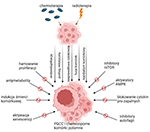Polyploidy as an outcome of anticancer therapies and a contributing cause of their lack of efficacy
DOI:
https://doi.org/10.18388/pb.2021_557Abstract
In addition to innate and gained resistance poliploidy of cancer cells is described as a mechanism responsible for lack of response or cancer relapses after initial patient recovery. Formation of these cells is induced by cyto- and genotoxic agents, which trigger endoreduplication, cytokinesis failure, cell fusion or canibalism. These processes lead to amplification of DNA, cell cycle arrest and escape from death. Cancer reinitiation results from depolyploidization by neosis, amitotic and meiotic-like divisions. In this paper we review the known mechanisms, which drive cancer cell transition to poliploidy, major features of these cells and their role in cancer progression. We also depict the current approaches, which target metabolic and signaling pathways that are crucial for survival and functioning of polyploid cells. The combination of chemotherapy and radiotherapy with agents capable of inhibiting or eliminating polyploid cells could substantially improve the success rate and efficacy of anticancer therapies.

Published
Issue
Section
License
Copyright (c) 2024 Kinga Kołacz, Karolina Gronkowska, Magdalena Strachowska, Agnieszka Robaszkiewicz

This work is licensed under a Creative Commons Attribution 4.0 International License.
All journal contents are distributed under the Creative Commons Attribution-ShareAlike 4.0 International (CC BY-SA 4.0) license. Everybody may use the content following terms: Attribution — You must give appropriate credit, provide a link to the license, and indicate if changes were made, ShareAlike — If you remix, transform, or build upon the material, you must distribute your contributions under the same license as the original. There are no additional restrictions — You may not apply legal terms or technological measures that legally restrict others from doing anything the license permits.
Copyright for all published papers © stays with the authors.
Copyright for the journal: © Polish Biochemical Society.



